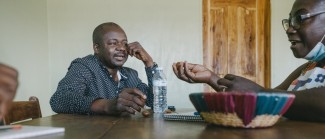Least developed countries (LDCs) receive only 6% of the private finance mobilized globally through blended finance, and even then funds are concentrated in a handful of LDCs while ‘last mile’ countries, sectors and businesses miss out. These were key findings from a joint UNCDF and OECD report that proposes actions to redress that imbalance as Covid-19 increases LDCs’ needs.
Between 2012 and 2018, LDCs received around $13.4 billion, or 6%, of commercial capital deployed through blended finance, a structure that uses grants, aid or concessional funding to attract private money to impactful but higher-risk investments. In contrast, 74% went to upper-middle-income and low-and-middle-income countries, according to the Blended Finance for the LDCs 2020 report. And while LDCs’ share had nudged up to 7.5% by 2018, this was mostly due to data-disclosure changes.
Forty-five of the 47 LDCs attracted blended private finance between 2012 and 2018, but it was unevenly distributed. Angola, Bangladesh, Myanmar, Senegal and Uganda each received over $1 billion – quadruple the amount 30 other LDCs received. This was partly because sectors that are an easier sell for private capital, with or without development financing support, dominate blended-finance flows. In 2017-2018, energy, banking and financial services attracted 50% of private funds mobilized by blended finance.
The report underscored the damage Covid-19 has inflicted on LDC economies and trade. Supply chain disruptions and declining global demand have dented exports, which even pre-crisis represented only around 1% of the global total. Collapsing tourism arrivals and plunging commodity prices have hurt many. SMEs have suffered disproportionately, especially those led by women and in the textile, personal care, hospitality and energy sectors.
To enable blended finance to help LDCs recover from the crisis and build forward better, the report made four key recommendations.
1. Support the development of local financial markets
Helping build local market actors’ capacity is key, for example through strengthening national development banks’ role in deploying blended finance. Local capital markets and local currency financing solutions should also be cultivated to mobilize domestic commercial banks and investors.
“It’s super-important to make sure we use what available domestic resources are there,” agrees Anders Berlin, Director of UNCDF’s Least Developed Countries’ Investment Platform (LDCIP).
LDC banks sometimes sit on excess liquidity that they prefer to invest in government treasury bills than in local businesses, he notes. The challenge is that “for them, it’s a rational choice.” When weighing treasury bills offering decent returns and negligible repayment risk against lending to small businesses that promise similar returns but apparently high risk, most domestic banks choose the former, he explains.
Using ODA funds to provide first-loss or percentage guarantees on loans can tip the balance. A 25% partial risk guarantee, for example – where a funder agrees to compensate banks for 25 cents in every dollar they lose – can incentivize them to lend. LDCIP can guarantee up to 70% but always tries to minimize concessionality and maximize banks’ “skin in the game”, Berlin says.
Offering finance to a borrower without credit history – usually with preferential rates or terms – can also encourage local commercial banks to lend simultaneously or later. In 2018, LDCIP extended a $250,000 working capital loan to a Ugandan renewable energy company that lacked collateral or borrowing history. Once the company had demonstrated its ability to service the debt by making four timely repayments to LDCIP, Uganda’s STANBIC Bank offered it an $800,000 facility, including a $150,000 import loan.
Finding ways around many LDC banks’ insistence that borrowers offer collateral can also help, Berlin adds. To demonstrate the creditworthiness of borrowers based on their revenue streams, LDCIP helps domestic banks conduct cash-based analysis for funding. Also, because LDCIP does not require collateral on its own loans, borrowers can reserve any collateral to secure additional commercial debt.
2. Design blended finance solutions for the hard to reach
The report also flags a need for innovative blended finance structures that target the ‘last mile’ people, sectors and geographies that are most underserviced by private funders.
Proposals including directing more resources and risk-mitigation tools at ‘missing middle’ enterprises. While microfinance institutions can cater for smaller SMEs with loans of up to $50,000 and commercial banks often only lend upwards of $500,000 to larger SMEs, firms in between have fewer financing options and so a greater need for blended solutions if domestic or international capital is to come in, Berlin notes.
Technical assistance can be another valuable risk-mitigation tool for borrowers in sectors that commercial lenders avoid but which are vital for LDC economies, such as fintech, agriculture or tourism, he adds. It improves the borrower’s operational sustainability and the transaction’s financial viability, helping ensure the desired impact is achieved.
For additional risk mitigation with harder-to-reach borrowers such as smallholder farmers, there may be a case for using grant money within blended finance structures to purchase private insurance, Berlin adds.
The report highlighted the IFC’s blended finance de-risking solutions to support on-lending from Working Capital Solutions to women-owned and women-led enterprises. Its IDA Private Sector Window contribution also includes a pooled first-loss guarantee and a limit expansion facility to enable its global trade finance programme (GTFP) to leverage over $1 billion of trade finance in eligible countries.
3. Improve impact management and measurement
Lack of transparency also hinders the growth of blended finance, the report argues, calling for better impact management and measurement, plus collaboration and sharing of knowledge and best practices.
“When we support companies, we need to make sure that we’re also showing which SDGs we’re supporting,” notes Berlin. To this end, UNCDF is trying to develop tools to jointly rate transactions’ impact risk and reward as well as their financial risk and reward.
The impact industry’s current use of multiple methodologies for measuring social or environmental impact however ultimately reduces their coherency and credibility. Stakeholders must work together to make impact measurements as consistent and commonly understood as credit ratings, he argues.
4. Bring blended finance to scale with systemic approaches
Scaling up blended finance is essential as LDCs seek to build more sustainable and resilient economies post-Covid. The report called for more systemic approaches through incorporating blended finance into coordinated multilateral crisis responses, national recovery and sustainable development plans, and prioritising scalable projects in sectors that drive inclusive, sustainable, green and resilient recovery.
The small size of most LDC transactions means blended finance actors should aggregate deals into portfolios that are also diversified across geographies, themes and currencies before approaching private investors to contribute capital, Berlin suggests. UNCDF’s BUILD Fund follows this approach. Even development finance institutions will rarely consider a transaction below $5 million, he explains. And while pension funds in developing countries should be attracted to infrastructure investments, for example, because the long-term nature of these assets matches funds’ liabilities, most institutions are concerned about the risk of investing in a single domestic infrastructure project, he notes.
The report also singles out climate-compatible infrastructure, clean energy, oceans-based sectors, digital finance and e-commerce solutions as suitable targets for blended finance. These will be critical for inclusive, resilient and sustainable development but have been overlooked historically as not all yet offer private investors sufficient financial returns without grant support.
If you would like to reuse any material published here, please let us know by sending an email to EIF Communications: eifcommunications@wto.org.



